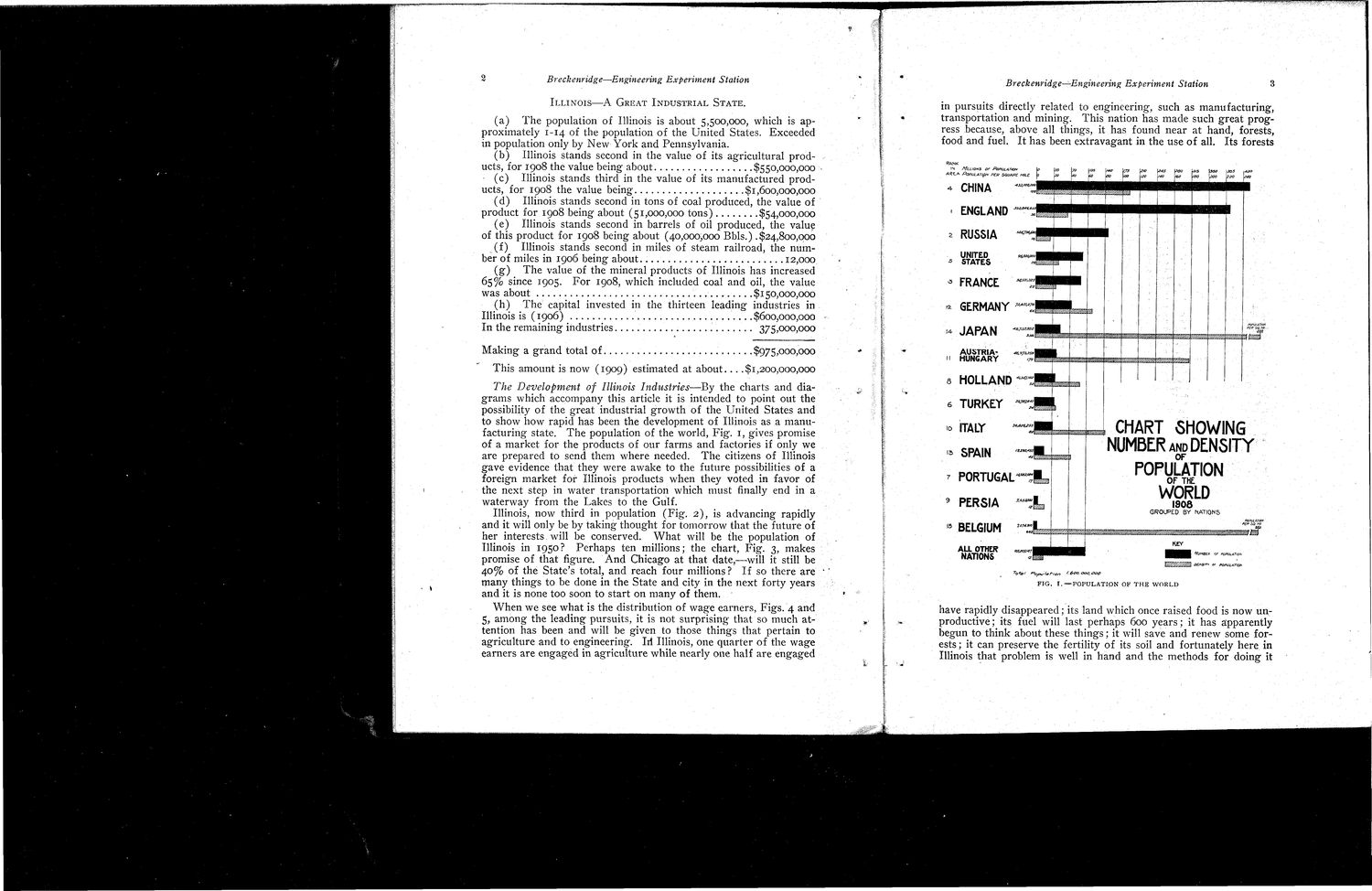| |
| |
Caption: Booklet - Engineering Experiment Station and Industry (1909)
This is a reduced-resolution page image for fast online browsing.

EXTRACTED TEXT FROM PAGE:
2 Breckenridge—Engineering Experiment Station I L L I N O I S — A GREAT I N D U S T R I A L STATE. Breckenridge—Engineering Experiment Station 3 (a) The population of Illinois is about 5,500,000, which is approximately 1-14 of the population of the United States. Exceeded in population only by New York and Pennsylvania. (b) Illinois stands second in the value of its agricultural products, for 1908 the value being about $550,000,000 (c) Illinois stands third in the value of its manufactured products, for 1908 the value being . . .$1,600,000,000 (d) Illinois stands second in tons of coal produced, the value of product for 1908 being about (51,000,000 tons) $54,000,000 (e) Illinois stands second in barrels of oil produced, the value of this product for 1908 being about (40,000,000 Bbls.) .$24,800,000 (f) Illinois stands second in miles of steam railroad, the number of miles in 1906 being about. 12,000 (g) The value of the mineral products of Illinois has increased 65% since 1905. For 1908, which included coal and oil, the value was about .$150,000,000 (h) The capital invested in the thirteen leading industries in Illinois is (1906) .$600,000,000 In the remaining industries 375,000,000 Making a grand total of $975,000,000 in pursuits directly related to engineering, such as manufacturing, transportation and mining. This nation has made such great progress because, above all things, it has found near at hand, forests, food and fuel. It has been extravagant in the use of all. Its forests RANK IN MILLIONS or PortU-Ar/ON ARELA PoRULATipn PCff SQUARE * CHINA • ENGLAND J* 2 RUSSIA UNITED •» STATES » FRANCE * GERMANY '•<• JAPAN 1 HUNGARY 1 AUSTRIA«WJW»I This amount is now (1909) estimated at about... .$1,200,000,000 The Development of Illinois Industries-—By the charts and diagrams which accompany this article it is intended to point out the possibility of the great industrial growth of the United States and to show how rapid has been the development of Illinois as a manufacturing state. The population of the world, Fig. I, gives promise of a market for the products of our farms and factories if only we are prepared to send them where needed. The citizens of Illinois gave evidence that they were awake to the future possibilities of a foreign market for Illinois products when they voted in favor of the next step in water transportation which must finally end in a waterway from the Lakes to the Gulf. Illinois, now third in population (Fig. 2), is advancing rapidly and it will only be by taking thought for tomorrow that the future of her interests will be conserved. What will be the population of Illinois in 1950? Perhaps ten millions; the chart, Fig. 3, makes promise of that figure. And Chicago at that dale,--will it still be 40% of the State's total, and reach four millions? If so there are many things to be done in the State and city in the next forty years and it is none too soon to start on many of them. When we see what is the distribution of wage earners, Figs. 4 and 5, among the leading pursuits, it is not surprising th.it so much attention has been and will be given to those things that pertain to agriculture and to engineering. lit Illinois, one quarter of the wage earners are engaged in agriculture while nearly one half are engaged a HOLLAND e TURKEY 1 ITALY 0 » SPAIN " i PORTUGAL* 9 a CHART SHOWING NUMBER AND DENSITY POPULATION OF THE PERSIA BELGIUM ALL OTHER NATIONS r * .' « « • oti>/ f^opu/at-ion '• 600, 000,000 WORLD 1908 GROUPED BY NATIONS NUMBLH or c 0£fiSir> or POPUIATIQH FIG. I.—POPULATION OF T H E WORLD have rapidly disappeared; its land which once raised food is now unproductive; its fuel will last perhaps 600 years; it has apparently begun to think about these things; it will save and renew some forests; it can preserve the fertility of its soil and fortunately here in Illinois that problem is well in hand and the methods for doing it
| |